Art Fairs
Dealers Proclaim a Return to Form for Frieze New York, With Healthy Sales Across the Spectrum and Increased International Traffic
The VIP preview was packed with buyers looking to spend.
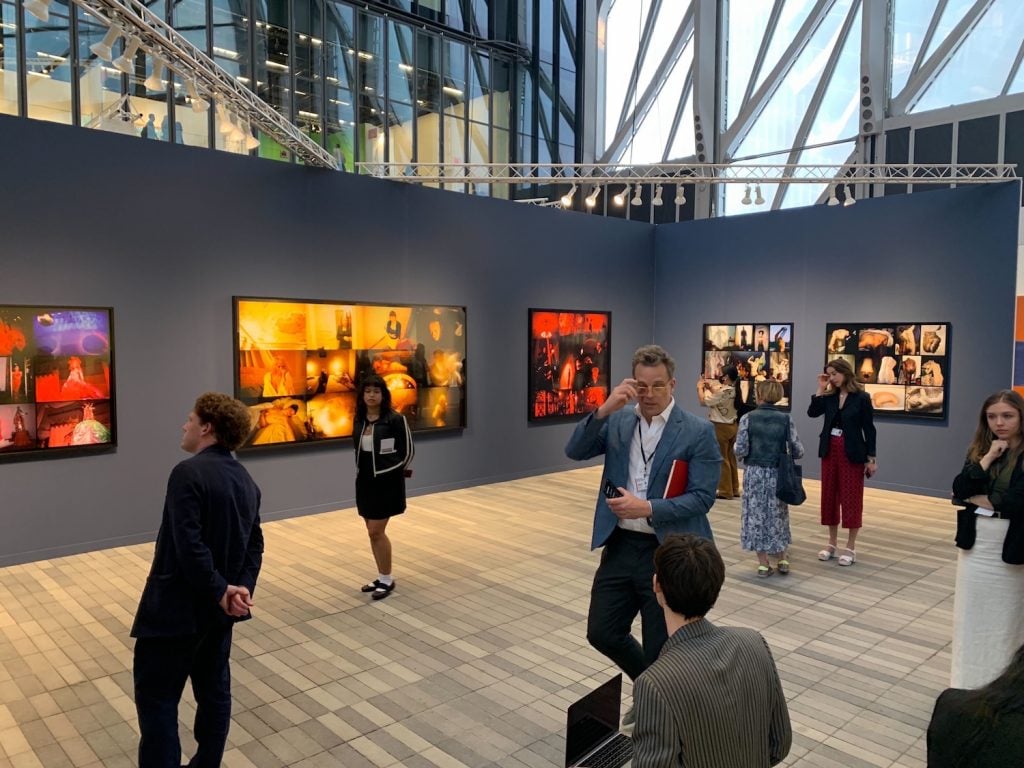
The VIP preview was packed with buyers looking to spend.

Eileen Kinsella

The latest edition of Frieze New York, which relocated to the Shed in Hudson Yards in 2021 from its former home on Randall’s Island, opened to throngs of VIPs yesterday. Dealers reported brisk sales as crowds navigated up and down the escalators to check out nearly 70 exhibitors across multiple levels and focused sections throughout the day.
That gallery number is still a fraction of the capacity Frieze used to have when it was held at a bespoke tent on Randall’s Island in the East River, starting in 2012, when it hosted roughly 190 galleries annually, but visitors have largely embraced the new venue. Frieze New York was one of the first major fairs to attempt a physical comeback in 2021, amid still-strict mask and capacity protocols at the time. As with many other major fairs that returned in a somewhat scaled-down format or in fits and starts, the overall fair vibe finally feels back to pre-pandemic normal. And that includes a flood of first-day sales.
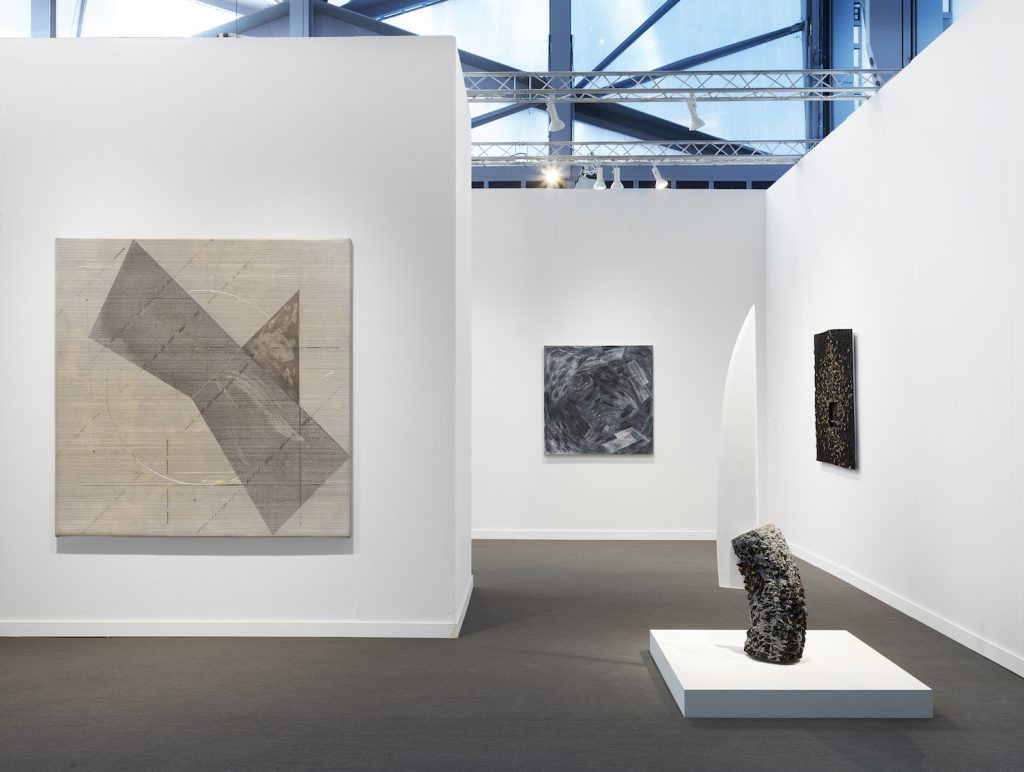
Installation view, Jack Whitten at Hauser & Wirth at Frieze New York. © Jack Whitten Estate
Photo: Sarah Muehlbauer, courtesy of the Estate and Hauser & Wirth.
In its return to form, galleries were not taking too many chances, and sought to impress with focused solo presentations and palatable paintings.
“It’s wonderful to be back at the Shed,” said Hauser & Wirth president Marc Payot. The gallery organized a solo presentation devoted to American abstractionist Jack Whitten. “Five years after his death, Jack’s work continues revealing new and incredible powers—here through a group of works spanning the decades of his career, including never-before-exhibited early black-and-white works on paper, as well as paintings and the rarely-seen sculpture Apollonian Sword.”
Opening-day sales included: an untitled 1976 canvas for $2.5 million; Physis II (Dedicated to the Memory of David Budd) (1991) for $600,000; The Mingo Altarpiece: For George Mingo 14 September 1950–6 December 1996 (1996) for $950,000; The Great Loop #2 (2012) for $95,000; and Black Hands (2014–15), for $800,000.
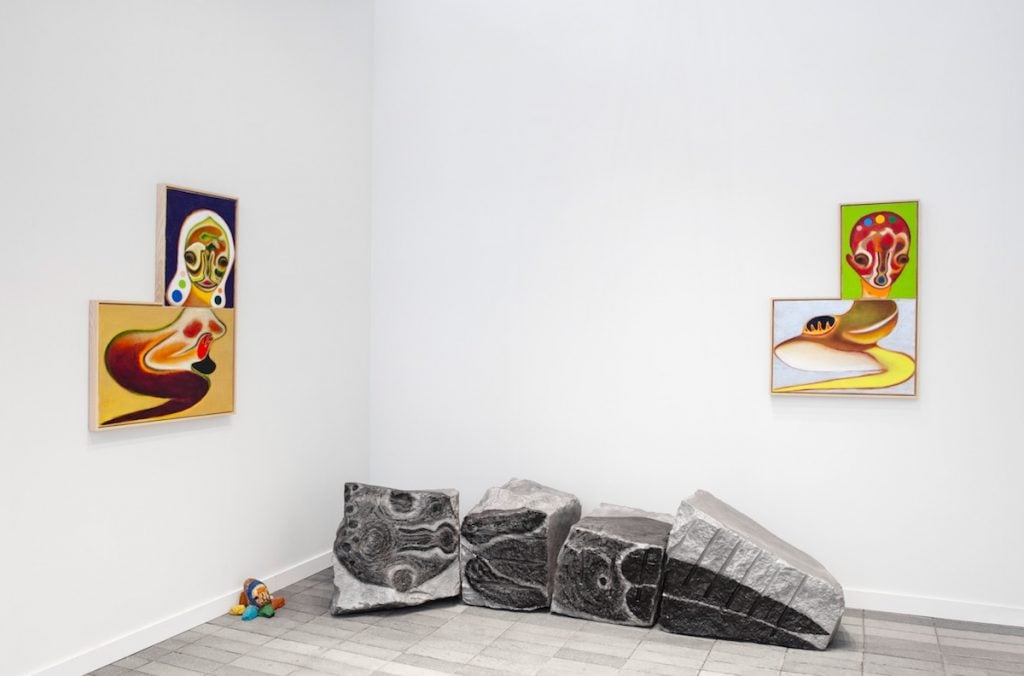
Installation view of Izumi Kato at Perrotin at Frieze New York. Courtesy of Perrotin.
“Frieze day one was particularly crowded this year, compared to the last few,” said Perrotin New York partner Peggy Leboeuf. “From 11 a.m. until closing, our booth seemed full and there was great energy,” she said. The gallery had an expansive presence, including a solo “corner” of artworks by Japanese artist Izumi Kato that sold out on the first day, and which was consistently drawing a crowd of enthusiastic observers.
Kato’s practice is rooted in the Shinto belief that everything, even objects like rocks and wood, contains a spirit. He sources materials like stones and textiles, which invoke historic precedents in Japanese folk art traditions, from his environment. The Frieze presentation includes a series of stone sculptures, aluminum sculptures, and new oil paintings, ahead of a solo exhibition at Perrotin Paris in June.
Amid the packed two-week schedule of major auctions and art fairs (including TEFAF and Independent last week, and NADA along with Frieze this week), we asked dealers how the market’s saturation has impacted attendance and demand. Leboeuf noted that the gallery had hosted a group of 60 people from Mécènes, in the south of France, at the gallery on Tuesday night, adding, “It was a mixture of New Yorkers and internationals coming to the city this week.”
Noting that each fair has a different energy, she said, “We always try to tailor our booth accordingly. At TEFAF, our booth consisted of important historical works by artists on our roster, and at Frieze, we have mostly new works by both established artists and newer artists to the gallery. “
Perrotin also showcased works by artists with upcoming exhibitions at the gallery or in New York, including two sculptures (both sold) by Jean-Michel Othoniel, who has presentations at the Brooklyn Botanic Garden in July and Perrotin New York in November, and Rina Banerjee, who has a concurrent exhibition at Perrotin New York.
Other Perrotin sales included works by Jean-Marie Appriou, Mathilde Denize, Nick Doyle, Oli Epp, Vivian Greven, Zach Harris, Charles Hascoët, Leslie Hewitt, Kara Joslyn, JR, Nikki Maloof, Gabriel de la Mora, MSCHF, Danielle Orchard, Zéh Palito, and Xiyao Wang.
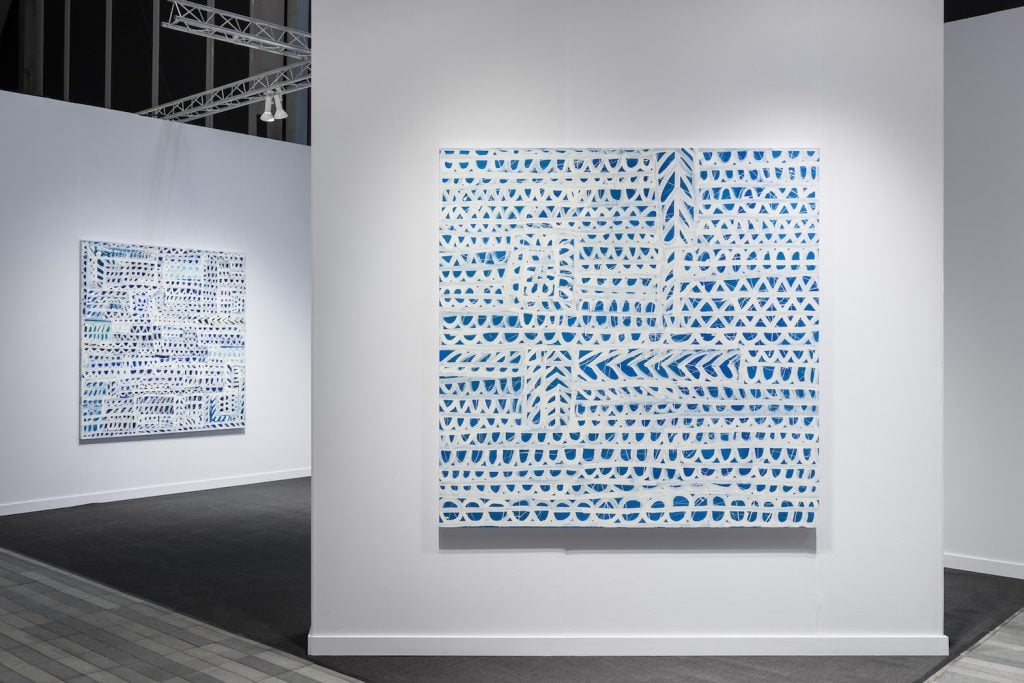
Installation view of paintings by Pam Glick at Stephen Friedman Gallery at Frieze New York. Courtesy of Stephen Friedman Gallery.
“Opening day of the fair was great—well attended, dynamic and upbeat,” said Mira Dimitrova, director of sales at Stephen Friedman Gallery, which devoted its booth to paintings by Pam Glick, who recently joined the gallery. “Our solo presentation of her work proved popular, with five works sold in quick succession. These were priced between $35,000 and $55,000 and were sold to NYC-based and international clients, as well as a corporate collection. We rehung the booth completely for day two.”
Last week the gallery announced it will be opening a new space in Tribeca, the first time it has expanded outside the U.K. “Frieze New York has been a great springboard for testing the market, and the success of previous editions here has paved the way for our expansion,” said Dimitrova.
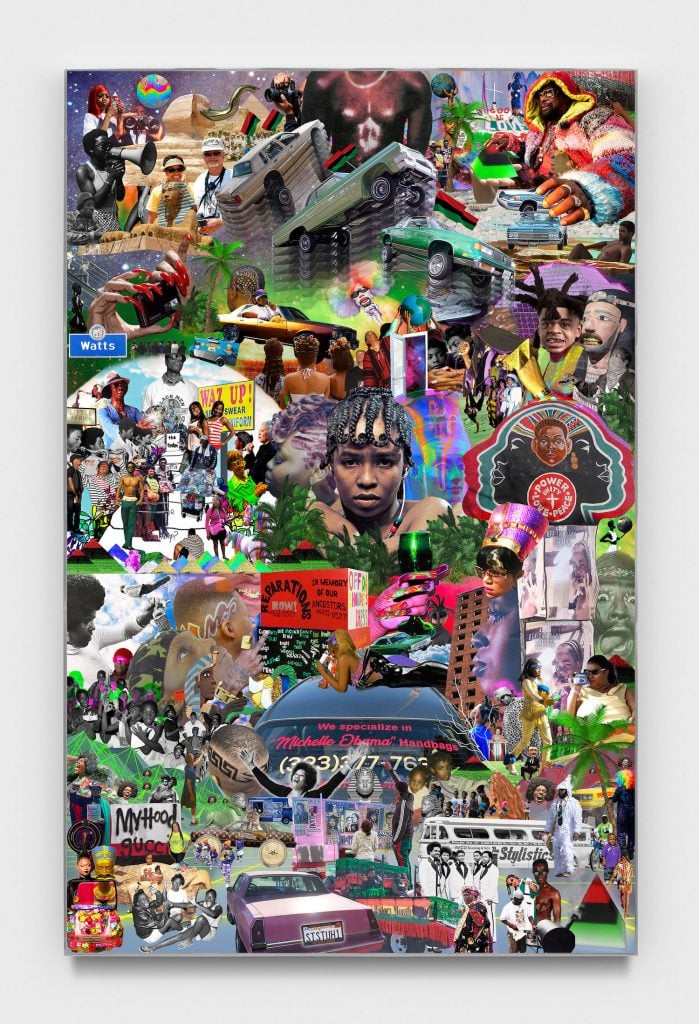
Lauren Halsey, Untitled (2023). Courtesy of the artist and David Kordansky Gallery.
David Kordansky Gallery sold out of a solo booth of works by Lauren Halsey, perhaps not surprising given the overwhelming response to her rooftop installation commissioned by the Metropolitan Museum of Art, which has been drawing accolades.
“During the first few hours, we placed all of Lauren Halsey’s new gypsum-based engravings and multiple editions of her digital collages with prominent collections worldwide,” said Kurt Mueller, senior director at the gallery. The gallery declined to disclose sale prices.
The engravings in this presentation directly relate to Halsey’s site-specific architectural structure on view at the Met, Mueller said. “These artworks feature a sweeping repository of iconography collected from her experience of living and being in South Central Los Angeles.”
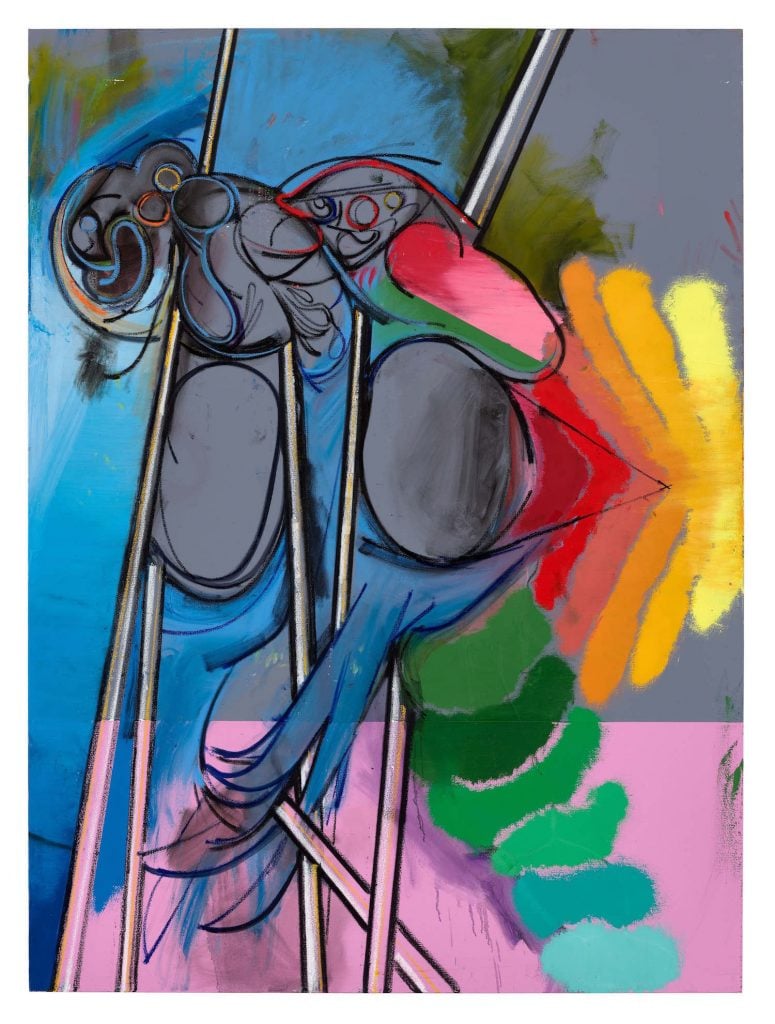
Daniel Richter, Where to Know (2023). © Daniel Richter / VG
Bildkunst, Bonn 2023, photo by Eric Tschernow, courtesy of Thaddaeus Ropac Gallery.
Thaddaeus Ropac found success with an eclectic mix of work by gallery artists, with at least half a dozen major sales made in the fair’s opening hours. These included two Martha Jungwirth paintings in oil on paper on canvas, Ohne Titel (2020) for €425,000 ($458,000) and another for €280,000 ($301,000); two Daniel Richter oils on canvas—Where to Know (2023) and Blumen aus Eisen (2023)—each for €375,000 ($404,000); Liza Lou’s Unbroken (2022) for $275,000; and Robert Longo’s Study of Cotton Field (2022), an ink and charcoal on vellum, for $90,0000.
Ropac called the VIP day “a really strong start,” noting the crowd was mostly American collectors, and a handful of international visitors, including clients from Asia. Further, some sales were made to new clients, he said.
As for the packed spring schedule in New York, Ropac said, “It’s great that these events have converged this year; it absolutely builds the momentum at this time and succeeds in drawing more people.”
Mega-gallery Pace mounted a solo presentation of drawings by market phenom Robert Nava. The drawings are studies for paintings from the body of work the artist will show at the Hall Art Foundation’s Kunstmuseum Schloss Derneburg, his first-ever solo museum exhibition in Europe, which opens in Germany on June 17. Only select works were for sale, as the curated solo presentation also includes loans from private collectors, the gallery said. But of the available works, all were placed yesterday, for prices ranging from $30,000 to $80,000.
David Zwirner, too, devoted its space to a single artist, selling multiple large-scale paintings and works on paper by Suzan Frecon, at prices between $50,000 and $500,000.
Sprüth Magers and Karma International placed multiple works from their joint solo presentation of Pamela Rosenkranz, including Anamazon (Wish Things) (2023) for $75,000, Anamazon (Amasses) (2023) for $75,000 to a collection in Europe, alongside additional paintings, sculptural editions and works on paper to collections in Asia, Europe, and the U.S. Rosenkranz’s large neon-pink sculpture Old Tree is currently a star attraction at the High Line (just steps away from the Shed on 30th Street).
New York’s James Cohan gallery reported selling its entire presentation of paintings by the in-demand artist Naudline Pierre, including one placement with an U.S. institution, for prices ranging from $45,000 to $130,000.
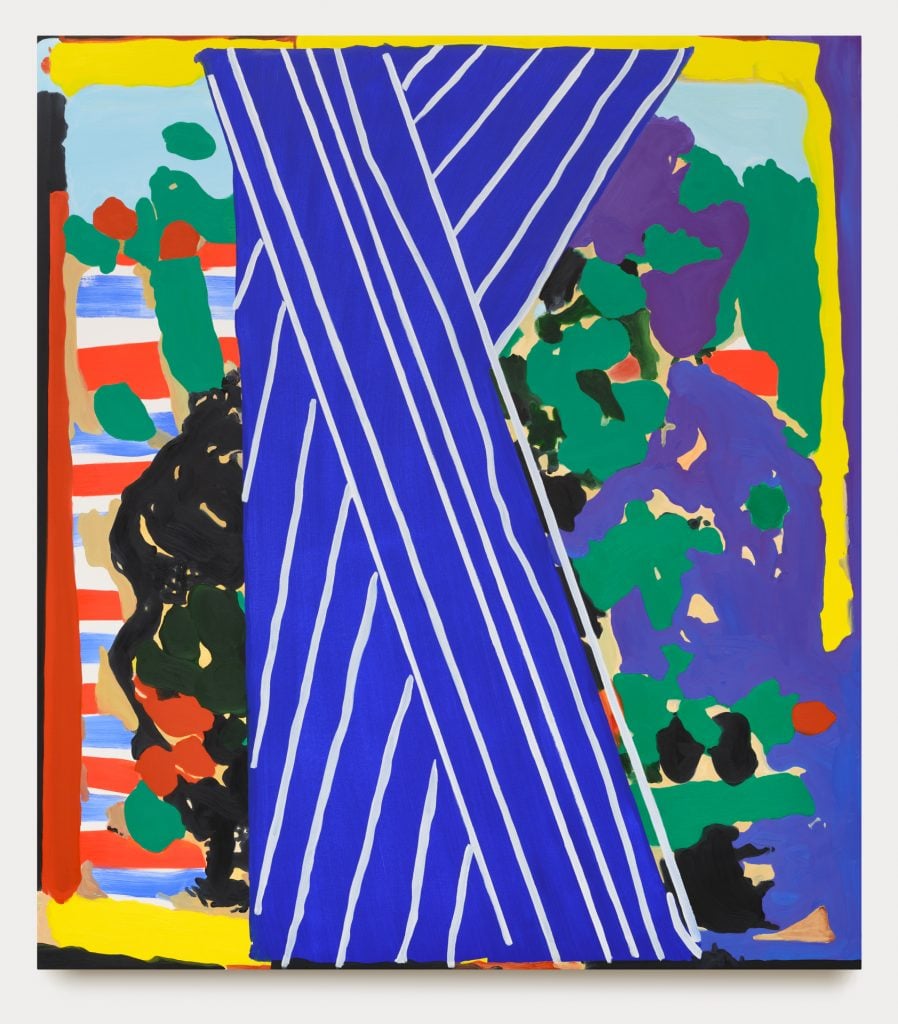
At Casey Kaplan, a major sculpture by Matthew Ronay ran the entire length of the booth. Previously exhibited at the Nasher Sculpture Center in Dallas, The Crack, the Swell, an Earth, an Ode (2022) is the largest the artist has ever produced at more than 23 feet long, and was sold for $300,000.
Canada confirmed it had sold multiple works from its presentation of Sahar Khoury and Elizabeth McIntosh, at prices ranging from $6,000 to $32,000.
And Cape Town-based Goodman Gallery sold works by William Kentridge, including a large bronze sculpture of a stovetop coffee pot for $500,000 to a private collection in New York, alongside a unique series of works on paper in the same price range to a European family foundation, plus a group of Sue Williamson embroideries to a European private collection at $55,000 each.

Sam Lipp, Pollution twink (2022). Courtesy of Derosia.
Among other sales reported by the end of VIP day, Los Angeles gallery Château Shatto, exhibiting in the Focus section dedicated to galleries under 12 years old, sold out a presentation of paintings by Julia Yerger in the $10,000 to $12,000 price range. Mitre, a first-time Focus exhibitor from Brazil’s Belo Horizonte, sold out their presentation of Marcos Siqueira, while nearby, downtown entrant Derosia closed sales of paintings by Sam Lipp in the range of $8,000 to $20,0000.
The fair’s director, Christine Messineo, remarked on “a stronger presence from Asia and Europe than in recent years,” and added: “Collectors are active, institutions are present and galleries have sold at all levels of the market.”